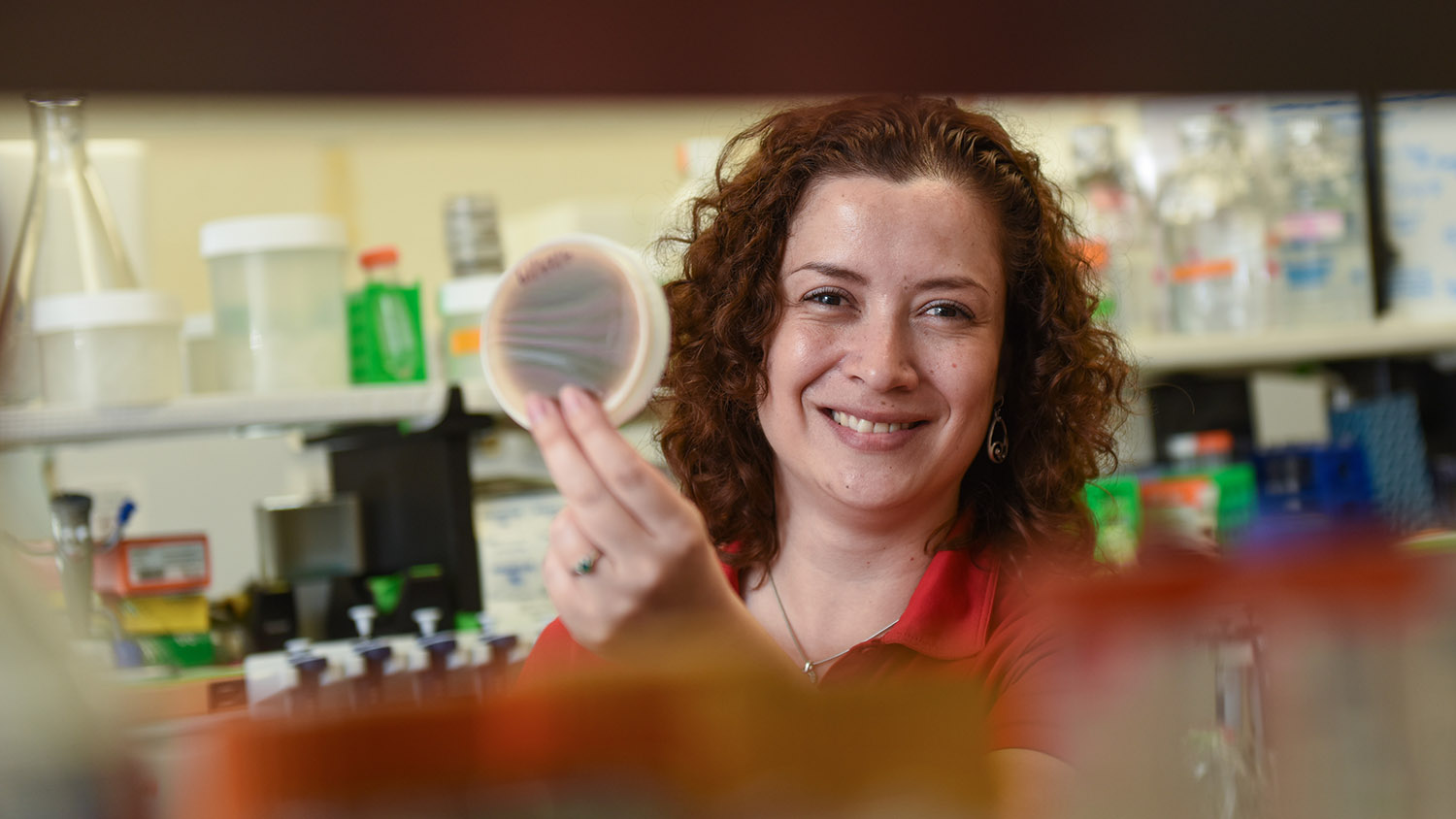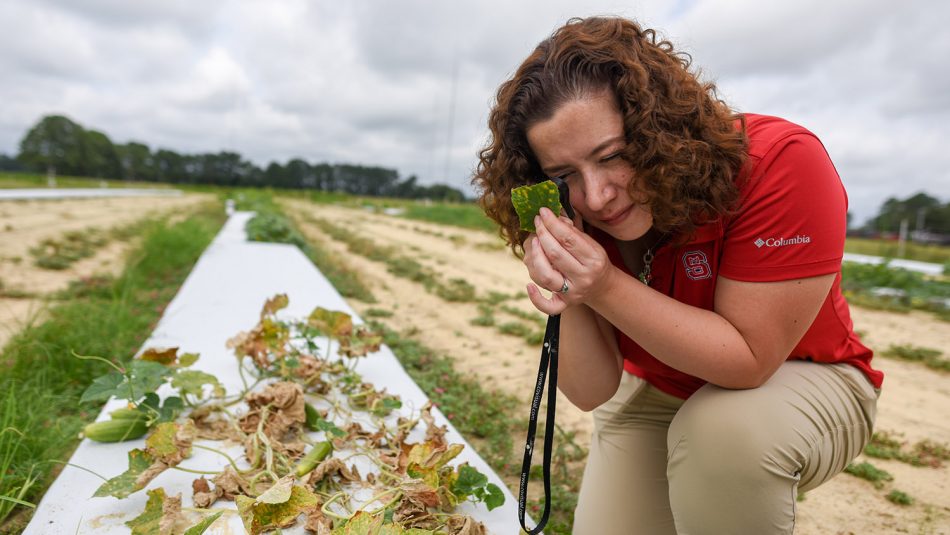On Call with Veggie Doc Lina Quesada-Ocampo

Written by Juliana McCully
From a holiday sweetpotato emergency to persistent cucumber pathogens, NC State’s Lina Quesada-Ocampo is on call and on the front lines with county Extension agents in helping vegetable growers deal with devastating plant diseases.
For Quesada, an associate professor in the Department of Entomology and Plant Pathology, her job is the perfect combination of research and application. And she’s good at it – so good that she was named a University Faculty Scholar earlier this year.
[pullquote color=”red” align=”right”]I really wanted a job that would allow me to use the tools I have learned through my career, from field research to genomics, then be able to apply that to solve problems for growers.[/pullquote]
“I really wanted a job that had application but would also allow me to use all the tools I have learned through my career, from field research to genomics, then be able to apply that to solve problems for growers,” she said. “I also really just love vegetable crops.”
Quesada, who joined NC State in 2013, studies diseases of cucurbit, sweetpotato and other crops. Her goal is to deliver science-based management strategies to North Carolina growers. In turn, growers have become partners in research, discovery and innovation, and Quesada finds the relationships to be both personally gratifying and important for the state’s agricultural and economic health.
How did you get into vegetable research?
I’m originally from Colombia and came to the U.S. to do a Ph.D. in plant pathology at Michigan State University. I also did a post-doc in plant and plant pathogen genomics. Back in Colombia, I had worked with cassava and really enjoyed focusing on a staple crop for developing countries. I also worked with the late blight of potato, a big crop for Colombia, and continued some of that work in the U.S. Through those experiences, I became fascinated with vegetables and specialty crops in general.
Specialty crops tend to be high value, but also high risk. What are some of the problems you’re working on to help growers lower those risks?
I work with a lot of vegetable crops in my program – sweetpotato, lettuce, pepper, all the cucurbits (cucumber, cantaloupe, watermelon, pumpkin, squash), and things like basil and hops, so quite a range. Our lab focuses on the state’s top five biggest vegetable crops, and each of those has anywhere from one to five disease problems, but there are always a couple that rise to the top.
In pickling cucumber, the biggest concern is cucumber downy mildew, an aggressive epidemic pathogen. In sweetpotato, black rot has caused a significant nationwide epidemic, especially for North Carolina as the No. 1 producer of sweetpotatoes.
Tell me more about black rot in sweetpotatoes.
When I started the job at NC State, I was almost disappointed to be working in sweetpotatoes, because it seemed like there were no issues. Growers would tell me, “Oh, no, we don’t get diseases in sweetpotatoes,” and that was true until 2014, when I noticed a lot more samples were infected with black rot and people were asking for solutions.
I didn’t have a historical sense of the disease, but the Plant Disease and Insect Clinic has a database going back to 2008, so I watched it and started recommending some things. I also happened to have a visiting scholar without a project, so I put him to work on collecting isolates to see if fungicides could kill the pathogen, just in case.
By the end of 2015, it was an epidemic, and it was bad. We went from levels of maybe 5 percent statewide to 85 percent and 100 percent in the packing houses. And it blew up in November and December, which is a very busy time for producers.
I’ll never forget it, because it was between Thanksgiving and Christmas, and no one knew what to do. They were asking if they should close the packing houses, because the pathogen was everywhere, and everything was rotting. One of the fungicides we tested was effective, and I was able to partner with the North Carolina SweetPotato Commission, the North Carolina Department of Agriculture and Consumer Services, and the U.S. Environmental Protection Agency to secure an emergency label to apply an effective fungicide post-harvest.
[pullquote color=”red” align=”left”]It was amazing — in three months, we had it cleaned up.[/pullquote]It was amazing – in three months, we had cleaned it up.
Fast-forward all these years later, and we have less black rot than ever, and we have been able to develop integrated management strategies to help avoid another crisis. That epidemic showed how little we knew about sweetpotato diseases – I was shocked when it hit, and it was difficult to design strategies when you need it next week without a good understanding of pathogen biology. Cucurbit growers have over 20 active ingredients they could use in an epidemic, but there were only about six for sweetpotatoes.
I am one of only two people in the country working on diseases of sweetpotatoes, and the other person doesn’t have an extension appointment, so they don’t do that kind of research. Because of that, and the trust we have built in our work together, growers help fund our programs. They are very supportive, because they are business people, and they look at the bottom line: Are you saving or making me money, yes or no? The answer is yes, so they are happy.
I don’t choose what the next problem is going to be – it’s just going to come to my table, and I work to fix it. Growers say, “We need you to work on this,’’ and that’s what I do. That can also mean switching gears quickly and having resilience, which can be difficult, but I like new and diverse things, and the funding provided by growers allows us to have that flexibility.

[pullquote color=”red” align=”right”]Everything we do is applied, in the end, to solve challenges for our growers.[/pullquote]
It’s also the beauty of our extension system, which is something most countries don’t have. When I moved here, I was fascinated and thought Extension and the land-grant system was the smartest idea ever – a mission that puts both scientists and citizens at the cutting edge of research to advance the life of citizens and translate it into solutions. Brilliant!
I have never seen my research as a separate thing from my Extension component but as a continuum. The basic tools are always in the service of the Extension mission, and everything we do is applied in the end to solve challenges for our growers.


